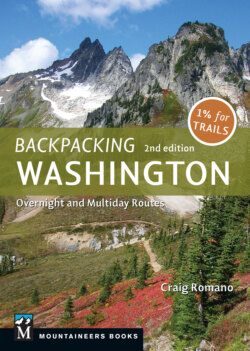Читать книгу Backpacking Washington - Craig Romano - Страница 18
На сайте Литреса книга снята с продажи.
TRAIL ETIQUETTE
ОглавлениеWe need to be sensitive to other trail users as well. Many of the trails in this book are open to an array of uses. Some are strictly for hikers, but others allow equestrians and mountain bikers (only a couple hikes in this book are open to motorbikes). When you encounter other trail users, follow common sense and exercise simple courtesy. With this Golden Rule of Trail Etiquette firmly in mind, here are other things you can do during trail encounters to make everyone’s trip more enjoyable:
Move off-trail for other users. When meeting other user groups (like bicyclists and horseback riders), the hiker should move off the trail. Hikers are more mobile and flexible than other users, making it easier for them to step off the trail.
Be respectful when you encounter horses. When meeting horseback riders, the hiker should step off the downhill side of the trail unless the terrain makes this difficult or dangerous. Make yourself visible so as not to spook the big beastie, and talk in a normal voice to the riders. This behavior calms the horses. If hiking with a dog, keep your buddy under control.
Stay on trails, and practice minimum impact. Don’t cut switchbacks, take shortcuts, or make new trails. If your destination is off-trail, stick to snow and rock when possible to protect fragile alpine meadows. Spread out when traveling off-trail to minimize the chance of compacting thin soils and crushing delicate plant environments.
Obey the rules specific to the trail you are visiting. Many trails are closed to certain types of use, including hiking with dogs or riding mountain bikes.
Leash or control your dog. Hikers who take dogs on trails should have their dog on a leash or under very strict voice command at all times. And if leashes are required or dogs are prohibited, then this does apply to you. Too many dog owners flagrantly disregard these regulations, setting themselves up for tickets, hostile words from fellow hikers, and the possibility of losing the right to bring Fido out on that trail in the future. Many hikers are not fond of dogs on the trail. Respect their right not to be approached by your loveable Lab. A well-behaved, leashed dog, however, can certainly help warm up these hikers to your buddy.
THE DEFECATION PROCLAMATION
The first rule of backcountry bathroom etiquette says that if an outhouse exists, use it. When privies aren’t provided, however, the key factor to consider is location. Choose a site at least 200 feet from water, campsites, and the trail. Dig a cat hole (a trowel comes in handy). Once you’re done, bury your waste and carry out your toilet paper with organic duff and place a “Microbes at Work” sign over it (just kidding about that last part). In highly popular areas and alpine zones, use a blue bag for your waste (required in many heavily used alpine and subalpine areas near Mount Baker in the Mount Baker–Snoqualmie National Forest).
Avoid disturbing wildlife. Observe wildlife from a distance, resisting the urge to move closer (use your telephoto lens), and control your dog if you are hiking with one. This not only keeps you safer but also prevents the wild animal from having to exert itself unnecessarily by fleeing from you.
Take only photographs. Leave all natural things, features, and artifacts as you found them for others to enjoy.
Never roll rocks off trails or cliffs. You risk endangering the lives of the people below you.
Mind the music. Leave the wireless speakers at home. Wear headphones if you must listen to music on the trail. Blasting music harasses wildlife, is a violation of wilderness ethics, and is an affront to those who come to the woods to seek solace.
Pack it in, pack it out. Anything you pack in must be packed out, even biodegradable items like apple cores and banana peels. “Leave only footprints, take only pictures” is a worthy slogan to live by when visiting the wilderness.
And while not every situation is addressed by these rules, you can avoid problems by always remembering to practice common sense and courtesy.
